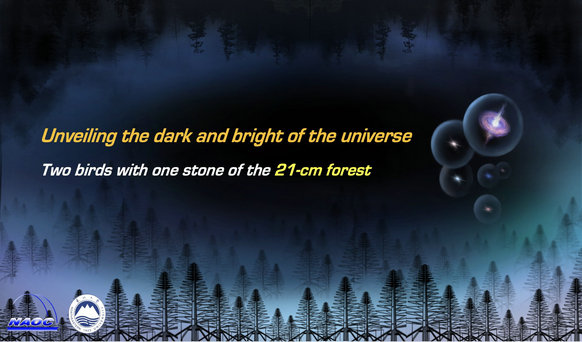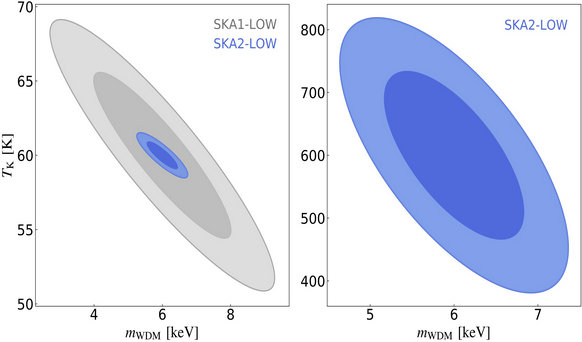Unveiling the dark and bright of the universe: the power of the 21-cm forest

The mystery of the first galaxies of the universe is an indomitable urge of human beings. The formation of them is mastered by the nature of dark matter which is also one of the most important problems faced by fundamental physics. The 21-cm absorption lines from neutral hydrogen against radio-bright sources at cosmic dawn, known collectively as the 21-cm forest, have been recently proposed to simultaneously probe dark matter and the first galaxies. This novel probe was explored by a joint research team from the Northeastern University and the National Astronomical Observatories of the Chinese Academy of Sciences (NAOC). Their work, entitled "The 21-cm forest as a simultaneous probe of dark matter and cosmic heating history", was published in Nature Astronomy on July 6, 2023.
The nature of dark matter is one of the most important problems faced by fundamental physics. To answer the question whether the dark matter is cold or warm, one key is to measure the dark matter particle mass through cosmological observations of small-scale structures. The dark matter particle mass has been constrained at low redshifts, but has never been constrained at cosmic dawn, when the first luminous objects form in the pristine dark matter halos. However, detecting the small-scale structures in which no star formation has ever occurred is rather difficult.
Fortunately, the atomic hydrogen gas in and around these dark small structures creates 21-cm absorption lines along the lines of sight against high-redshift radio point sources, known collectively as the 21-cm forest (Fig.1-left panel). The 21-cm forest on the source spectrum provides a unique probe to the small-scale structures during cosmic dawn. However, the 21-cm forest signals will be easily suppressed by the heating effect of the first galaxies in the early universe, making the detection very challenging (Fig.1-right panel). On the other hand, the early heating history by itself is a fundamental and unsettled problem in astrophysics and cosmology, which has a complex interplay with the formation of the first galaxies.

Fig.1: Left: an illustration of 21-cm forest signals produced by various structures along a line of sight towards a background source. Right: the effect of heating, parameterized by fX, on the transmission of 21-cm photons (Shao et al. 2023).
The probe of 21-cm forest was proposed more than twenty years ago, and it has been recognized for years as a sensitive probe for the gas temperature and potentially for dark matter properties during the cosmic dawn. However, detection has never been even attempted due to a number of challenges, including the extremely weak signals, the difficulty in identifying high-redshift background sources, and the degeneracy between the dark matter particle mass and the heating effect, preventing the probe from constraining either the dark matter particle mass or the heating effect from the first galaxies.
Over the recent years, a number of high-redshift radio-loud quasars are discovered and the SKA telescope went into the construction phase, and thus it is time to realize the 21-cm forest observations. Sparked by the power spectrum analyses widely used in cosmological probes, the authors realized that the distinctive scale-dependences of the signals caused by the warm dark matter effect and the heating effect, could be used to statistically extract the key features to distinguish the two effects.
In this work, a novel statistical solution was proposed to solve simultaneously the weak signal problem and the degeneracy problem, by measuring the one-dimensional (1-D) power spectrum of the 21-cm forest. The signal scale-dependence revealed by the amplitude and shape of the 1-D power spectrum (Fig.2) makes the 21-cm forest a viable and effective means to simultaneously measure dark matter properties and the thermal history of the universe. "By measuring the one-dimensional power spectrum of the 21-cm forest, we can not only make the probe actually feasible by increasing the sensitivity, but also provide a way to distinguish the effects of warm dark matter models and early heating process," said the authors, "we will be able to kill the two birds with one stone!"

Fig.2: The simulated 1-D power spectra of the 21-cm forest. (Shao et al. 2023)
In scenarios where the cosmic heating is not too severe, the low-frequency array of phase-one SKA is capable of effectively constraining both the dark matter particle mass and the gas temperature (Fig.3-left panel). In cases where the cosmic heating is more significant, the utilization of multiple background radio sources with the phase-two SKA still enables robust detection capabilities (Fig.3-right panel).

Fig.3: Constraints (68.3% and 95.4% confidence level) on TK and mWDM with the 1-D power spectrum of 21-cm forest at z = 9, assuming measurements along lines of sight against 10 background sources with S150 = 10 mJy. (Shao et al. 2023)
For dark matter constraints, the 21-cm forest offers a viable probe at high redshifts, exploring scales and redshift ranges beyond the reach of other observations. By measuring the heating level, the 21-cm forest provides a way to constrain the spectral properties of the first galaxies and the first black holes, so as to shed light on the nature of the first bright objects in the universe. It serves as an indispensable avenue for advancing our understanding of the early universe and peering into the mysteries of both dark matter and the first galaxies.
The realization of the 21-cm forest probe is closely tied to observations of high-redshift background radio sources. Therefore, the next step involves identifying more radio-bright sources at cosmic dawn (such as radio-loud quasars and gamma-ray burst afterglows) that can be followed up in the SKA era. It is highly anticipated that during the operation of SKA, the 21-cm forest will be further developed into a crucial tool for unraveling the nature of dark matter and the formation of the first galaxies.
The research paper is accessible on July 6, 2023, at https://www.nature.com/articles/s41550-023-02024-7.
Media Contact:
Prof. XU Ang
Email: annxu@nao.cas.cn
Web: http://english.nao.cas.cn